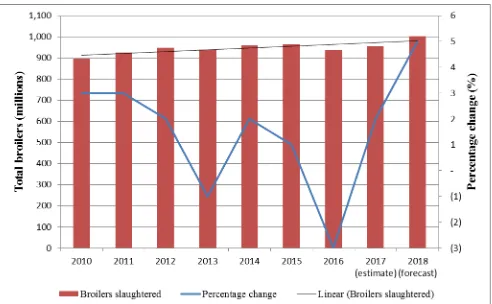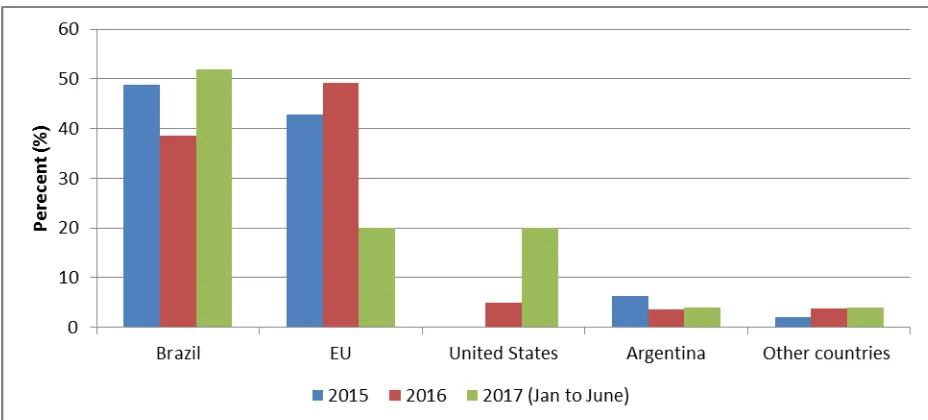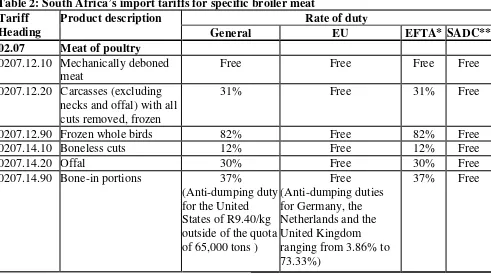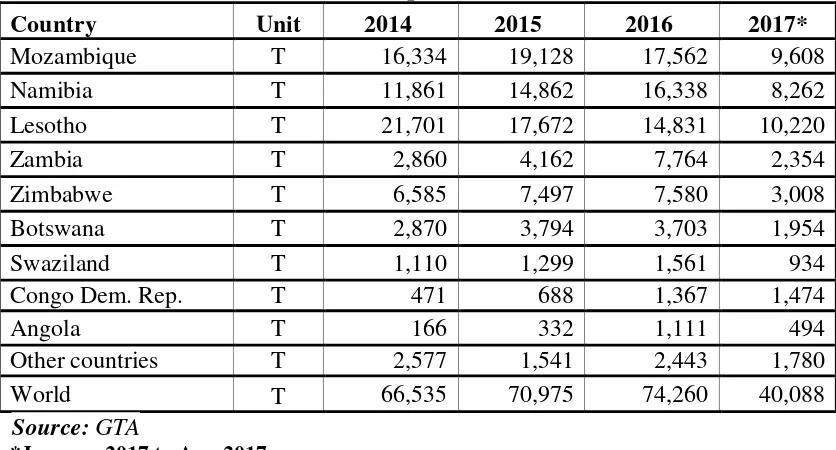THIS REPORT CONTAINS ASSESSMENTS OF COMMODITY AND TRADE ISSUES MADE BY USDA STAFF AND NOT NECESSARILY STATEMENTS OF OFFICIAL U.S.
GOVERNMENT POLICY
Currently, broiler production in South Africa is under pressure due to the outbreak of highly
pathogenic avian influenza (H5N8). As a result, Post estimates that the broiler imports will increase by about four percent to 525,000 tons in 2017 and by another two percent to 535,000 tons in 2018. U.S. broiler exports also increased in 2017 and are expected to remain stable in 2018. On the other hand, South Africa’s broiler meat exports are estimated to decrease by about 19 percent to 60,000 in 2017, a significant decline from the prior year. South African broiler production is expected to recover in 2018. The containment of bird flu combined with a decrease in feed prices is projected to suppress a higher growth rate in imports.
Worship Mugido Kyle Bonsu
South African Poultry Imports Forecast to Increase Due to
Avian Influenza
Poultry and Products Annual
South Africa - Republic of
Executive Summary:
Post estimates that broiler slaughterings will increase marginally by about two percent in 2017 to 955 million broilers (1.26 million tons of meat, excluding offal) in South Africa. Currently, broiler production is under pressure due to the ongoing outbreak of H5N8. However, Post forecasts that broiler slaughterings will increase by about five percent, reaching 1,003 million broilers (1.32 million tons of broiler meat) in 2018, due to recovery from H5N8 and the continuation of low-priced animal feed. [In 2017, South Africa recovered from drought with a record high corn harvest of 17 million tons, which led to a decrease in the price of feed.]
Post forecasts that broiler meat imports will increase by about two percent in 2018 to about 535,000 tons, as the recovery of South African broiler production is projected to suppress a higher growth rate. Post estimates that South Africa’s broiler meat exports will decrease significantly by about 19 percent to 60,000 tons in 2017 and remain at that level in 2018. This is due to South Africa’s current inability to export poultry to certain countries as a result of the export ban imposed on South African poultry by many Southern African countries.
Commodities:
Production
The South African poultry meat industry is the country’s largest individual agricultural industry boasting a gross value of about R37 billion (US$2.8 billion) and contributing about 15 percent to the total gross value of agricultural products. Broiler production makes up most of the poultry industry. Although South Africa produces only about 1.5 percent of the world’s broiler meat, the poultry industry is the major broiler producer in Southern Africa, accounting for close to 80 percent of total broiler production in the region.
Post has adjusted the number of broilers slaughtered in 2015 and 2016 as new data from the industry became available. Approximately, 965 million broilers were slaughtered (equal to 1.3 million tons of meat, excluding offal) in 2015. However, in 2016, the number of broilers slaughtered declined by three percent to 936 million broilers (1.2 million tons of broiler meat, excluding offal). This decrease is partly due to the drought, which led to an increase in feed costs (see Figure 1).
Currently, broiler production is under pressure due to the outbreak of highly pathogenic avian influenza (H5N8) in South Africa. As of September 28, 2017, the South African Department of Agriculture, Forestry and Fisheries (DAFF) confirmed 79 cases of avian influenza outbreaks, with 25 of those cases in commercial poultry operations. South Africa has since culled more than 3.2 million birds, mainly in the breeder stock and layer operations.
The South African poultry industry’s current recovery from drought will be offset by the avian influenza outbreak. Due to the severe drought that hit the Southern Africa region in 2015 and 2016, the production of corn fell by almost 30 percent resulting in historically high animal feed prices. In 2017, South Africa recovered from drought with a record high corn harvest of 17 million tons, which led to a decrease in the price of feed (see South Africa Corn Exports Accelerate in the Midst of a Record Crop).
Given the above, Post estimates that broiler slaughterings will increase marginally by about two percent in 2017 to 955 million broilers (1.26 million tons of meat, excluding offal). Post
forecasts that broiler slaughterings will increase by about five percent, reaching 1,003 million broilers (1.32 million tons of broiler meat) in 2018, due to the continuation of low-priced animal feed and recovery from avian influenza.
Figure 1: Total broilers slaughtered per annum in South Africa Source: The South Africa Poultry Association (SAPA)
Feed cost: Feed cost is one of the major cost factors in the broiler industry and can contribute as
much as 75 percent to the total cost of a broiler producer. The broiler industry suffered dramatic feed price increases in 2016, as the prices of corn increased significantly due to the drought. Corn is the major ingredient (more than 50 percent inclusion rate) in broiler feed and any change in the price of corn impacts directly on the profit margin of broiler producers. In mid-January 2016, both white corn and yellow corn prices traded at historically high levels of R5,280/ton ($391) and R4,130/ton ($306), respectively, when the rand depreciated to more than
R16.50/US$ and the severity of the drought started to be realized by role players in the South African grain value chain. However, in 2017, many parts of South Africa received good rains, and a historically high corn harvest of about 17 million tons is expected in the 2017/18
marketing year, which is about 108 percent higher than last season’s harvest. Therefore, the price of feed is expected to decrease, resulting in an improvement in potential profitability of broiler production.
Consumption
meat (of which most is broiler meat) increased by more than 80 percent, from 22 kg per person per year in 2000 to 40 kg per person per year in 2016. As poultry meat is relatively affordable and ubiquitous, it has grown to be the most important protein source in the diet of the majority of South Africans.
Table 1: Per capita consumption (kg) of meat in South Africa
Years Beef Poultry meat Pork Mutton/lamb
2000 15.6 21.5 3.0 3.8
The producers, retailers and the foodservice sector also responded to this increased demand for protein by supplying the market with competitively priced, value-added and convenient poultry products. Currently, retail sales account for more than 50 percent of total meat sales in South Africa, followed by wholesale (approximately 25 percent) and foodservices (approximately 15 percent), with the foodservice sector growing more quickly than retail and wholesale trade in recent years.
South Africa’s economy is expected to grow by less than two percent in the next two years, as lower commodity prices, labor unrest, policy uncertainty, corruption and prospects of a weaker global economy will impact negatively on economic growth. As already mentioned, meat consumption in South Africa has expanded rapidly over the past decade and while continued growth in meat consumption is projected in the coming decade, slower economic growth will result in slower consumption growth relative to the past.
and about 1.795 million tons in 2018. In 2016, South Africa consumed about 1.665 million tons of broiler meat.
Trade
Imports: Broiler meat accounts for 95 percent of all poultry meat imports by South Africa, with
the balance largely being turkey products (also see Figure 2). Post estimates that broiler meat imports will increase by about four percent in 2017 to 525,000 tons as South African broiler production is under pressure due to the outbreak of H5N8. Post forecasts that broiler meat imports will increase by about two percent in 2018 to 535,000 tons, as the recovery of the South African broiler production after the avian influenza outbreak and lower feed costs are projected to suppress a high growth rate of imports. In 2016, South Africa imported 504,310 tons of broiler meat, up 14 percent from 2015. These imports represent about 30 percent of South Africa’s local consumption of broiler meat.
Figure 2: The trend in poultry meat imports by South Africa Source: Global Trade Atlas (GTA)
2016, the United States exported almost 25,000 tons of broiler meat to South Africa. As of August 31, 2017, the United States has exported 55,000 tons of broiler meat to South Africa at a value of about US$44 million.
On April 10, 2017, the International Trade Administration Commission of South Africa
announced the initiation of a sunset review of the anti-dumping duties on frozen bone-in chicken from the United States. This follows an application for anti-dumping duty review against United States imports by the South African Poultry Association. This sunset review will determine whether the anti-dumping duty against United States bone-in chicken exports to South Africa, above the 65,000 tons anti-dumping duty free quota will continue (see also Sunset review on anti-dumping duties). ITAC is still conducting its investigations.
In 2016, the European Union (EU) was the leading exporter to South Africa in terms of broiler meat, with about 50 percent market share of the import market (see also Figure 3 and Figure 4). In 2016, the major EU countries that exported broiler meat to South Africa were the
Netherlands, the United Kingdom (UK) and Spain. Brazil was the second largest exporter of broiler meat into South Africa with almost 40 percent market share of the import market in 2016. The United States was the third largest exporter of broiler meat into South Africa with about five percent market share.
South Africa has since banned poultry imports from certain EU countries due to the ongoing outbreaks of H5N8 in the EU. This has led to an almost 60 percent decline in the quantity of EU broiler meat exports to South Africa when comparing the first six months of 2016 and 2017. That market share has been mainly taken up by Brazil and the United States (see also Figure 4).
Figure 4: Origin of broiler meat imports into South Africa for the past three years Source: GTA
Figure 5 illustrates the percentage contribution of specific broiler meat products imported by South Africa since 2015. In 2017, Post estimates that broiler bone-in portions will represent the largest category of broiler meat imports at about 47 percent or about 246,750 tons. The share of broiler bone-in portions as percentage of total broiler meat imports has shown an upward trend since 2015. One reason for the increase is the expanded market access the U.S. gained in the 65,000 tons tariff rate quota for bone-in broiler meat.
The second largest category in volume is mechanically deboned meat with an estimated share of 36 percent or about 189,000 tons in 2017. Broiler bone-in portions and mechanically deboned meat represent almost 85 percent of total broiler meat imports by South Africa and are followed by offal (nine percent), whole chicken (five percent) and boneless cuts (two percent).
Table 2 (below) represents South Africa’s current import tariff structure for broiler meat
products. For most products, the European Union, due to the Economic Partnership Agreement (EPA) with South Africa, could import broiler meat tariff free into South Africa. However, other countries face import tariffs that range from 12 to 82 percent. For this reason, in February 2016, SAPA applied for the imposition of safeguard measures on frozen broiler bone-in portions under Article 16 of the Trade, Development and Cooperation Agreement (TDCA) between the
European Community (and its member states) and South Africa. In December 2016,the South African Department of Trade and Industry (DTI) imposed a provisional 13.9 percent safeguard duty on imports of EU chicken into South Africa. The safeguard duty expired on July 3, 2017. The DTI has yet to make an announcement about whether the import duty will be extended or not.
Table 2: South Africa’s import tariffs for specific broiler meat Tariff necks and offal) with all cuts removed, frozen
31% Free 31% Free
0207.12.90 Frozen whole birds 82% Free 82% Free
0207.14.10 Boneless cuts 12% Free 12% Free
0207.14.20 Offal 30% Free 30% Free
0207.14.90 Bone-in portions 37%
Source: The South African Revenue Services (SARS)
*EFTA - European Free Trade Association
** SADC – Southern Africa Development Community
Exports:
Poultry Export Ban
On June 22, 2017, the World Organization for Animal Health (OIE) published a notification of an outbreak of highly pathogenic avian influenza in a breeder flock in South Africa, which killed 5,000 chickens. This led Southern African countries, including Botswana, Malawi,
Forestry (MWAF) announced a relaxation of the import suspension of poultry and poultry products from South Africa. This relaxation applies only to poultry and poultry products originating from certain “compartments” approved by DAFF to be free of bird flu (see Namibia relaxes ban of poultry imports from South Africa).
Against this background, Post estimates that South Africa’s broiler meat exports will decrease significantly by about 19 percent to 60,000 tons in 2017. This is due to South Africa’s current inability to export poultry to certain countries as a result of the export ban imposed by certain Southern African countries. Post forecasts that South Africa’s broiler meat exports will remain flat (60,000 tons) in 2018 as it could take South Africa some time to get closed markets back.
Table 3: South African broiler meat exports
Country Unit 2014 2015 2016 2017*
Table 4: PS&D table for broiler meat
Poultry, Meat, Broiler 2016 2017 2018
Market Begin Year Jan 2016 Jan 2017 Jan 2018
South Africa USDA Official New Post USDA Official New Post USDA Official New Post
Inventory (Reference) 0 0 0 0 0 0





